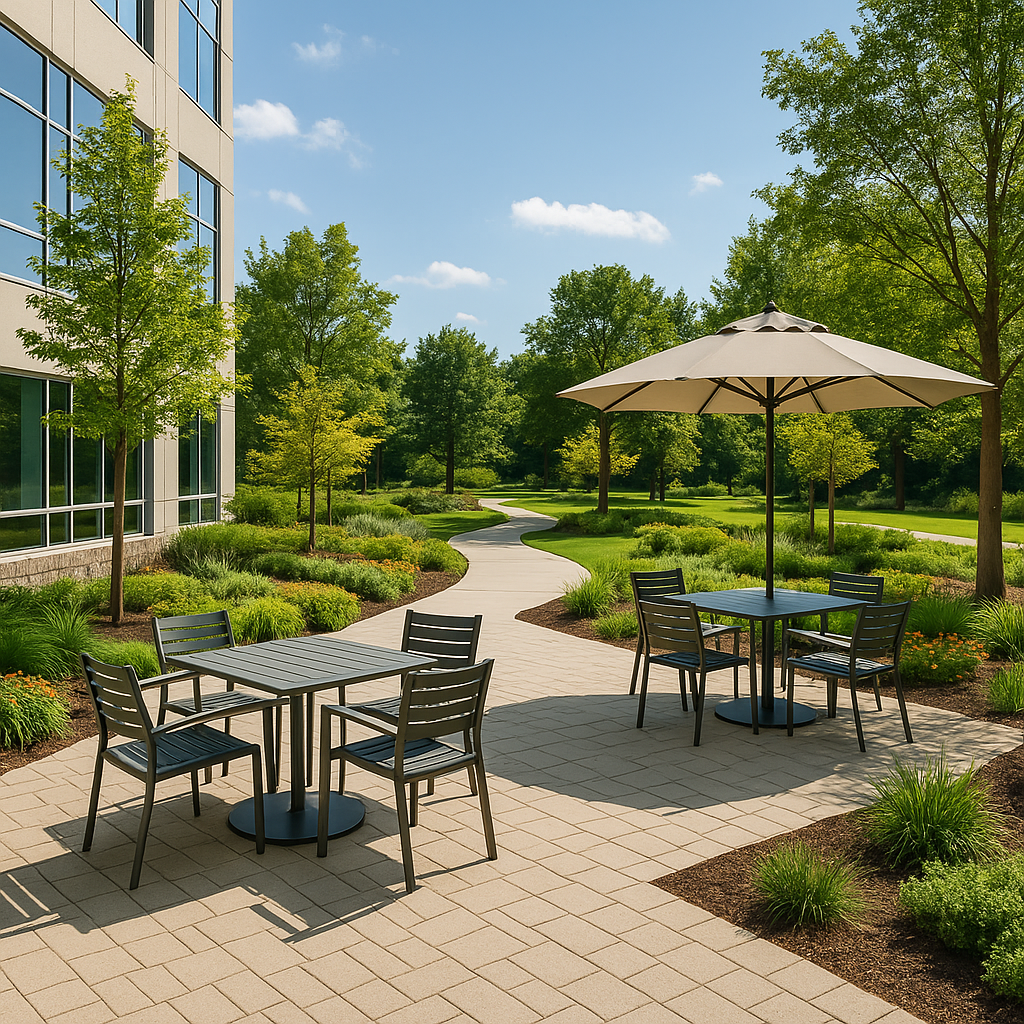As the boundaries between work and leisure evolve, so too must the spaces where we live, work, and connect. A beautiful landscape that supports both productivity and relaxation offers a vital asset for modern offices, campuses, and communal environments. These multifunctional green spaces not only boost well-being and performance but also reinforce a sense of community and ecological responsibility.
This guide explores how thoughtful landscape design architecture merges nature and function to support outdoor work and leisure.
Why Work-Leisure Integration Matters in Landscape Design
Rise of Hybrid Workspaces
With more people working remotely or in flexible settings, outdoor spaces now serve as alternative work environments. A beautiful landscape equipped for connectivity, comfort, and focus enables workers to perform in natural surroundings.
Enhancing Mental and Physical Health
Access to green outdoor environments improves mood, reduces stress, and boosts physical activity, leading to healthier, happier teams and communities.
Maximizing Usable Real Estate
Outdoor spaces are underutilized assets. Turning them into productive zones expands usable square footage without new construction.
Learn more in Beautiful Landscape Balancing Greenery and Usability.
Core Elements of Outdoor Work-Leisure Spaces
Landscape Drawing with Purpose
A functional landscape drawing outlines zones for solo work, collaboration, and downtime. Key considerations include:
- Shade structures and tree canopies
- Wi-Fi coverage and power access
- Acoustic buffering
- Proximity to buildings and walkways
Adaptive Furniture and Surfaces
Flexible furnishings like movable seating, laptop tables, picnic setups, and informal seating steps allow for a variety of postures and uses.
Multi-Zone Functionality
Spaces must accommodate diverse users: workstations by day, social hubs by evening. Dividing areas with plantings, lighting, or elevation changes helps support multiple functions simultaneously.
Seasonal Design Planning
Incorporate evergreen plants, all-weather furnishings, retractable canopies, and heating elements to ensure year-round usability.
Sustainable Practices that Support Work & Leisure
Native, Low-Maintenance Plantings
Choose regionally appropriate species that require less irrigation and upkeep, ensuring dependable beauty and functionality.
Permeable Paving and Drainage
Surfaces that absorb rain prevent puddling and make seating and work areas more accessible after storms.
Energy-Efficient Lighting
Install low-glare, solar-powered lighting to provide safety and ambiance without excess energy use.
Rain Gardens and Cooling Trees
Reduce heat with canopy trees and bioswales that collect stormwater and improve microclimate comfort.
Explore transit-linked applications in Beautiful Landscape Tailored for High-Traffic Areas.
Enhancing Leisure and Social Opportunities
Breakout Gardens and Quiet Nooks
Design tranquil spaces with benches, trellised vines, and sound-absorbing plantings for private calls, reading, or short breaks.
Collaboration Pods and Outdoor Meeting Areas
Provide shaded, furnished settings with writable surfaces or digital projection options for small group sessions.
Recreational Green Spaces
Lawns or turf zones support fitness breaks, yoga sessions, and casual games, encouraging balance and well-being.
Café Patios and Food Truck Zones
Landscape features like plaza pavers, built-in seating, and windbreaks enhance dining and gathering during breaks.
Strategic Pathway Integration
Connecting Destinations
Paths should link indoor offices, outdoor zones, parking, and entry points, encouraging usage throughout the day.
Wayfinding and Circulation Design
Use lighting, color cues, signage, and plantings to guide movement and create a sense of arrival and orientation.
See Beautiful Landscape That Integrates Pathways and Views for more pathway concepts.
Role of the Landscape Contractor
Holistic Site Evaluation
A qualified landscape contractor ensures environmental conditions, usage patterns, and accessibility needs are considered from the outset.
Material and Plant Selection
Contractors identify durable, site-appropriate materials and plantings that perform under constant use and shifting seasons.
Phased Construction Plans
To minimize disruption, they manage staged implementation and ongoing adjustments as site usage evolves.
Long-Term Maintenance Strategy
Professionals develop maintenance programs tailored to hybrid use zones, including cleaning, repairs, pruning, and seasonal refreshes.
Best Practices for Outdoor Work-Leisure Landscapes
- Design for both sunlight and shade access
- Ensure power and Wi-Fi are weather-protected and easy to reach
- Prioritize seating comfort and modularity
- Use sustainable and slip-resistant materials
- Maintain sightlines for safety without sacrificing privacy
Final Thoughts
In a rapidly changing work environment, outdoor spaces serve a dual role as havens for productivity and relaxation. A beautiful landscape that supports both work and leisure elevates user satisfaction, enhances health, and improves site performance.
From thoughtful landscape drawing to responsive landscape contractor execution, successful spaces embrace flexibility, sustainability, and beauty. By bridging function and form, outdoor environments become extensions of office culture and public life—vital zones where productivity meets peace.
Investing in such landscapes is not only a visual upgrade but a strategic move toward a healthier, more engaged, and forward-thinking community.

